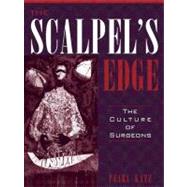The Scalpel's Edge The Culture of Surgeons

The Scalpel's Edge The Culture of Surgeons
- ISBN 13:
9780205270071
- ISBN 10:
0205270077
- Edition: 1st
- Format: Paperback
- Copyright: 10/12/1998
- Publisher: Pearson
Rent
Sorry, this item is currently unavailable.
Note: Supplemental materials are not guaranteed with Rental or Used book purchases.
Extend or Purchase Your Rental at Any Time
Need to keep your rental past your due date? At any time before your due date you can extend or purchase your rental through your account.
Summary
This ethnography about the culture of surgeons describes how and why they differ significantly from other physicians. Historically rising from humble roots as lower-class, uneducated, itinerant barbers, the profession has evolved into one of the most prestigious in America, one that utilizes the most sophisticated technologies in medicine. Surgeons have nonetheless retained many aspects of their historical culture, such as their proclivity for quick decisions, surgical "cures," and their detachment and aloofness from patients and other physicians. This book describes in detail what surgeons actually do in and out of the operating room. It reveals how they think about disease, patients, and other physicians; how their thinking is often non-scientific; how they make decisions; and how they keep secrets from patients and colleagues.This book gives a detailed description of a professional culture and how the culture, especially their active posture, influences decisions which affect patients and the health care system. The book discusses the methodology used to obtain and maintain trust with the surgeons and how the behavior was interpreted (1). Chapter 2 explains how history can help us understand why particular culture traits appear in the culture of surgeons. Thorough descriptions of the barriers to effective communication between surgeons and their patients, and the implications of these barriers, are in chapters 5 and 6. Case studies describe how many decisions are made based on complex issues, including professional ties and financial interests (7, 8, and 9). And also includes a detailed description of operating room rituals (10).For anyone with an interest in medical culture.






